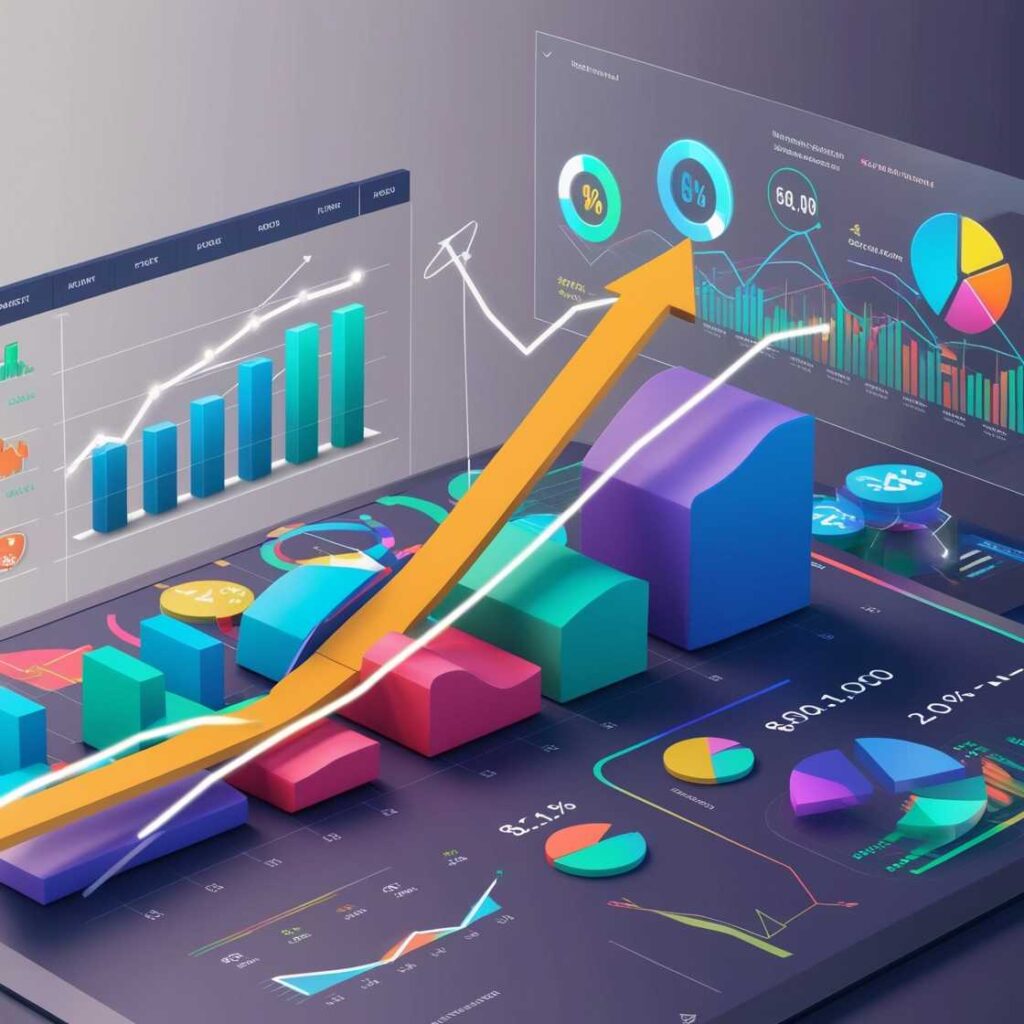
Financial Data Visualization: How Motion Graphics Can Bring Financial Reports and Trends to Life
In today’s fast-paced, digital-first world, financial reports can feel like a language only insiders understand. Graphs, pie charts, and spreadsheets full of tiny numbers are important, yes—but let’s be honest: they aren’t exactly easy to digest or fun to look at. This is where motion graphics swoop in to save the day. Imagine transforming those static financial reports and trend analyses into engaging, animated visuals that not only make sense but are also, dare we say, enjoyable to watch.
Now, financial data isn’t known for being flashy, but motion graphics can change that. They turn those numbers, percentages, and trends into captivating stories. In this article, we’re diving deep into how motion graphics make financial data more accessible, digestible, and memorable. We’ll explore why they work, the different types of motion graphics that can revitalize your financial presentations, and how to use them effectively to grab attention and drive understanding.
Let’s break it down into bite-sized pieces so you can see how motion graphics might just become your financial report’s best friend.
Why Motion Graphics Work Wonders for Financial Data
Motion graphics excel at making complex concepts clear. By animating data points, highlighting key trends, and providing smooth transitions, they turn numbers into visuals that just click. Here’s why they’re so effective:
- Engagement: People are 60,000 times faster at processing visuals than text, and animations draw attention like nothing else.
- Simplification: Motion graphics simplify complex data by zooming in on key figures and animating trends.
- Retention: Studies show that people remember about 10% of what they read but retain around 95% of what they see in videos.
- Professionalism: Animated visuals scream high quality and professionalism. A well-designed animation shows that you care about how your data is received.
Motion graphics make it easy for anyone, whether a financial analyst or an everyday investor, to grasp important trends, spot opportunities, and understand risks.
The Key Motion Graphics Techniques That Bring Financial Data to Life
Not all motion graphics are the same. Different types of animations can help you showcase different elements of your financial data. Here’s a breakdown of the types of motion graphics that work best in financial reports and presentations:
1. Animated Infographics
Infographics are already popular for data presentation, but animated infographics kick things up a notch. Imagine bar charts rising up in real time, line graphs showing growth over time with a moving dot, or percentages climbing toward a target number. Animated infographics make it feel like the data is actively telling a story.
For example, in quarterly revenue reports, you can animate growth across different months with bars that grow, changing colors as they hit key benchmarks.
2. Data Transitions and Visual Cues
Static reports don’t emphasize where to look first or what’s most important. But with motion graphics, visual cues like color changes, expanding shapes, or directional arrows can subtly guide viewers’ attention. A revenue report could begin with a focus on overall profits before zooming in on specific revenue streams, or it could use color-coded transitions to separate positive and negative trends.
3. Timeline Animations
Finance often involves looking at data over time, such as market growth, sales trends, or year-over-year comparisons. With timeline animations, you can smoothly show data changing over days, months, or years. This is perfect for showing cyclical trends, like stock market fluctuations or seasonal sales patterns.
Picture a timeline of your company’s annual growth, with each year’s results fading in and out while a line graph visually connects the dots. This approach is engaging and lets viewers see the progression without scrolling through endless pages.
4. Interactive Motion Graphics
Interactive animations allow viewers to engage with the data directly. While these are more complex, they are perfect for audiences who want to dive deep into specific parts of a financial report. Interactive graphs can display data in layers, letting viewers click on different segments to get more details or shift between time frames.
Imagine a company’s financial report where the viewer can click on any quarter to see detailed income and expenses, complete with animated breakdowns of each category.
5. 3D Data Visualization
3D motion graphics add depth to financial data, making it both eye-catching and memorable. This technique can make big data sets more approachable by arranging them in a virtual 3D space where users can zoom in or out. Picture a 3D pie chart where the largest segments pop out toward the viewer for emphasis.
This is particularly effective when you’re presenting multiple data points and want to help viewers identify trends or patterns within a complex set.
Why Motion Graphics Drive Audience Engagement and Understanding
So, why do motion graphics work so well for financial data? Here are some benefits that will resonate with both analysts and everyday viewers.
1. They Cut Through the Clutter
Motion graphics let you take complex data and boil it down to the essentials. They’re like a highlighter pen for your reports, pointing out what’s worth noting and glossing over the rest. This visual clarity helps your audience get to the good stuff fast.
2. They Make Financial Data Feel Relevant
Let’s face it—financial reports aren’t everyone’s cup of tea. But when you turn static numbers into moving visuals, you’re telling a story. Motion graphics make people feel invested (pun intended). Suddenly, even the driest metrics feel like they have purpose and direction.
3. They Showcase Trends in Real-Time
One of the most powerful features of motion graphics is the ability to show data changing in real-time. Imagine an animated chart showing stock price fluctuations over the day, with each shift in the line indicating a significant movement in the market. Real-time data visualization can be a game-changer for audiences who want to follow along with live data, such as in financial news segments.
4. They Add a Dash of Entertainment
Financial reporting can feel tedious, but a well-done motion graphic adds an element of fun. A creative animation style, smooth transitions, and compelling visuals can make even earnings reports look interesting. It’s a bit of dopamine that makes it easier to keep watching—and ultimately, easier to understand.
The Do’s and Don’ts of Using Motion Graphics in Financial Reports
Just because you can add motion graphics doesn’t mean you should go overboard. Here’s a quick guide to using them effectively.
Do: Keep It Clean and Focused
Use motion graphics sparingly and make sure each animation has a purpose. Highlight only the key trends and let them shine. Overly complex animations can end up confusing viewers, so make sure the visuals are crystal clear.
Don’t: Overuse Effects or Styles
It can be tempting to use flashy effects, but too much can look unprofessional. Stick with a cohesive style, using similar colors, fonts, and transitions throughout your report.
Do: Prioritize Storytelling
Each financial report has a narrative. Are you showing growth over time, contrasting revenue streams, or pointing out risks? Build your motion graphics to support that story.
Don’t: Neglect Accessibility
Not everyone has perfect vision or hearing. Provide captions, use high-contrast colors, and avoid flashing visuals that could be harmful to viewers with epilepsy. Inclusive design isn’t just good practice—it’s essential for reaching your whole audience.
Examples of How Motion Graphics Transform Financial Reports
Let’s look at some real-world examples to bring all these points home.
Case Study 1: Animated Financial Recaps for Internal Meetings
A retail company used motion graphics to present quarterly results to its executives. Instead of dozens of PowerPoint slides, they condensed their findings into a 3-minute animated video. Each department’s financial summary was presented with animated bar charts, growth lines, and revenue comparisons, highlighting wins and areas for improvement in a clear and memorable way.
Case Study 2: Financial Market Updates in Media
Financial news outlets frequently use motion graphics to explain stock trends and market updates in real time. Animated charts showing how indexes are performing, as well as visuals highlighting big movers, provide viewers with quick insights at a glance.
Case Study 3: Investment Prospectuses
An investment firm wanted to make its prospectuses more accessible to potential investors. Using motion graphics, they presented key financials, market growth, and portfolio allocation through animated graphs and visuals that made the data easy to interpret. Investors could interact with certain elements to get more details, adding an engaging layer of interactivity.
How to Implement Motion Graphics in Your Financial Reports
You don’t need to be a motion graphics wizard to start using these techniques in your financial reports. Here’s a simple roadmap:
- Identify the Key Metrics: Start by narrowing down your data to the most important metrics.
- Choose Your Style: Determine what kind of motion graphics fit your data. Simple bar animations? A 3D pie chart? Go with a style that enhances understanding.
- Work with a Designer (or Tool): If you’re not familiar with motion graphics software, there are designers and agencies who specialize in this. You can also find tools that let you create basic animations.
- Add Contextual Narration: A voiceover can add context, explain the animation, and walk viewers through each visual. It’s a great way to make sure nothing gets lost in translation.
- Test Before You Publish: Get feedback on your motion graphics before rolling them out widely. Check that your message comes through clearly and that viewers find it easy to follow.
Bring Your Financial Data to Life with Just Animations
Ready to take your financial data from “meh” to mesmerizing? Just Animations can help. With expertise in creating custom motion graphics designed for clarity and engagement, we turn your reports into compelling visual stories. Whether you’re presenting quarterly results, showcasing growth trends, or providing live financial insights, we create visuals that elevate your data and keep your audience hooked. Don’t settle for boring spreadsheets—let’s make your numbers speak for themselves. Connect with us at Just Animations and see how our motion graphics can bring your financial stories to life.




